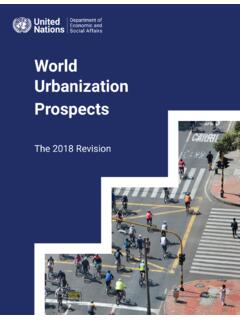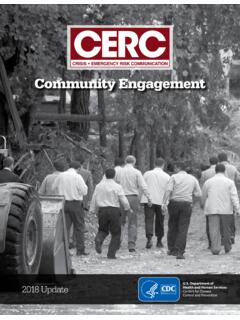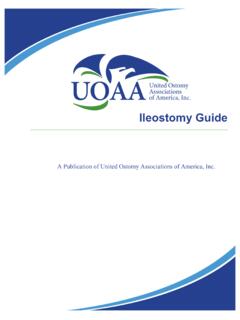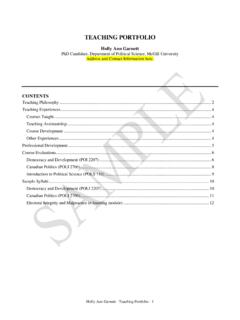Transcription of THE STATE OF WORLD FISHERIES AND AQUACULTURE
1 WORLD FISHERIES AND AQUACULTURETHE STATE OF 2018201820 1820 18 MEETING THE SUSTAINABLE DEVELOPMENT GOALSABIDJAN, C TE D IVOIRE. Offloading tunasCOVER PHOTOGRAPH FAO/Sia KambouThis flagship publication is part of THE STATE OF THE WORLD series of the Food and Agriculture Organization of the United citation:FAO. 2018 . The STATE of WORLD FISHERIES and AQUACULTURE 2018 - Meeting the sustainable development goals. Rome. Licence: CC BY-NC-SA designations employed and the presentation of material in this information product do not imply the expression of any opinion whatsoever on the part of the Food and Agriculture Organization of the United Nations (FAO) concerning the legal or development status of any country, territory, city or area or of its authorities, or concerning the delimitation of its frontiers or boundaries.
2 The mention of specific companies or products of manufacturers, whether or not these have been patented, does not imply that these have been endorsed or recommended by FAO in preference to others of a similar nature that are not 978-92-5-130562-1 FAO 2018 Some rights reserved. This work is made available under the Creative Commons Attribution-NonCommercial-ShareAlike IGO licence (CC BY-NC-SA IGO; ).Under the terms of this licence, this work may be copied, redistributed and adapted for non-commercial purposes, provided that the work is appropriately cited.
3 In any use of this work, there should be no suggestion that FAO endorses any specific organization, products or services. The use of the FAO logo is not permitted. If the work is adapted, then it must be licensed under the same or equivalent Creative Commons license. If a translation of this work is created, it must include the following disclaimer along with the required citation: This translation was not created by the Food and Agriculture Organization of the United Nations (FAO). FAO is not responsible for the content or accuracy of this translation.
4 The original English edition shall be the authoritative edition. Any mediation relating to disputes arising under the licence shall be conducted in accordance with the Arbitration Rules of the United Nations Commission on International Trade Law (UNCITRAL) as at present in materials. Users wishing to reuse material from this work that is attributed to a third party, such as tables, figures or images, are responsible for determining whether permission is needed for that reuse and for obtaining permission from the copyright holder.
5 The risk of claims resulting from infringement of any third-party-owned component in the work rests solely with the , rights and licensing. FAO information products are available on the FAO website ( ) and can be purchased through Requests for commercial use should be submitted via: Queries regarding rights and licensing should be submitted to: and Agriculture Organization of the United NationsRome, 20182018 MEETING THE SUSTAINABLE DEVELOPMENT GOALSWORLD FISHERIES AND AQUACULTURETHE STATE OF ISSN 1020-5489| ii |CONTENTSFOREWORD viMETHODOLOGY viiiACKNOWLEDGEMENTS ix ACRONYMS AND ABBREVIATIONS xiPART 1 WORLD REVIEW 2 Overview 2 Capture FISHERIES production 7 AQUACULTURE production 17 Fishers and fish farmers 30 The fishing fleet 35 The status of fishery resources 39 Fish utilization and processing 47 Fish trade and commodities 52 Fish consumption 69
6 Governance and policy 75 PART 2 FAO FISHERIES AND AQUACULTURE IN ACTION 86 FISHERIES and the Sustainable Development Goals: meeting the 2030 Agenda 86 FAO s approach to improving the quality and utility of capture fishery data 92 Combating illegal, unreported and unregulated fishing: global developments 98 Biodiversity, FISHERIES and AQUACULTURE 102 Global inland FISHERIES revisited: their contribution to achievement of the SDGs 108 Fish for food security and human nutrition 113 Implementing the ecosystem approach to FISHERIES and AQUACULTURE achievements and challenges 120 PART 3 HIGHLIGHTS OF ONGOING STUDIES 130 Climate change impacts and responses 130 Small-scale FISHERIES and AQUACULTURE 138 Realizing AQUACULTURE s potential 144 International trade.
7 Sustainable value chains and consumer protection 149 Selected ocean pollution concerns 154 Social issues 157 PART 4 OUTLOOK AND EMERGING ISSUES 166 Blue growth in action 166 The emerging role of regional cooperation for sustainable development 172 The role of regional fishery bodies in AQUACULTURE development 176 Disruptive technologies 178 Projections of FISHERIES , AQUACULTURE and markets 182 REFERENCES 194| iii |TABLES, FIGURES AND BOXES TABLES 1. WORLD FISHERIES and AQUACULTURE production and utilization 42.
8 Marine capture production: major producer countries 93. Marine capture production: major species and genera 104. Capture production: FAO major fishing areas 135. Inland waters capture production: major producer countries 166. AQUACULTURE production of main groups of food fish species by continent, 2016 207. Major species produced in WORLD AQUACULTURE 238. WORLD AQUACULTURE production of aquatic plants 259. Major farmed seaweed producers 2510. AQUACULTURE food fish production by region and selected major producers 2711.
9 WORLD employment for fishers and fish farmers by region 3112. Number of fishers and fish farmers in selected countries and territories and worldwide 3213. Reporting of sex-disaggregated employment (women, men and unspecified) in FISHERIES and AQUACULTURE , by region, 2016 3314. Sex-disaggregated engagement in the primary sector of FISHERIES and AQUACULTURE in selected countries 3415. Reported number of motorized and non-motorized vessels by LOA class in fishing fleets from selected countries and territories, 2016 3816.
10 Top ten exporters and importers of fish and fish products 5517. Share of main groups of species in WORLD trade of fish and fish products, 2016 6418. Total and per capita apparent fish consumption by region and economic grouping, 2015 7219. SDG 14 indicators for which FAO is custodian or contributing agency 8920. Percentage of countries adopting EAF or similar ecosystem approaches, by region 12521. Examples of adaptation options for FISHERIES and AQUACULTURE 13522. Projected fish production, 2030 18523.



















